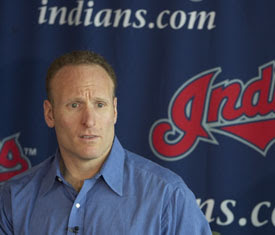 There is a common belief in sports, business, or any other competitive, performance-driven endeavor that says, "If you aren't getting better, you're getting worse."
There is a common belief in sports, business, or any other competitive, performance-driven endeavor that says, "If you aren't getting better, you're getting worse."Excellence is a matter of constant maintenance. No person or organization that aspires to greatness stands pat and assumes that they've carved a toe hold on the mountain of success, a floor which they will not sink beneath.
We've seen it with Tiger Woods, an obsessive competitor who has repeatedly remade his swing in an attempt to eradicate any flaw. We've seen it with Michael Jordan in his later career, perfecting a fall-away jumper after he returned from minor league baseball a step slower. Those two athletes, possibly the greatest players their respective sports have ever seen, are the ones who could be excused before all else if they decided to coast a bit here and there. But Woods never does. Jordan never did. They don't because they know standing still is competitive suicide.
Indians GM Mark Shapiro is apparently taking a different approach. One that embraces the belief that a baseball team, like fine wine, needs time to age, time for chemical reactions to take place and molecules to find their proper places so that, by the time you pop the cork on that vintage Merlot, it has reached its full flavor potential.
But it only takes a quick glance at the Tribe's offensive statistics to come to the conclusion that so far, Shapiro only has a Thermos full of grape juice to work with.
When it became apparent earlier this season that the offense was going to become a long-standing problem, Shapiro said he wanted his team to "heal itself from within." That could be interpreted many ways. Does he want the farm system to ride to the rescue the way they did lat year? So far, Ben Francisco, and possibly Michael Aubrey, have been the only bright spots delivered to the lineup from Buffalo.
Does he want struggling established players like Travis Hafner, Ryan Garko and Casey Blake to look deep inside themselves to find the reasons why they seem to strike out at every single RBI opportunity? So far, soul searching hasn't led to any enlightenment.
Does he want more coaching from the coaches? Does he want more managing from Eric Wedge? The Internet lynch mobs that want to ride Wedge and hitting coach Derek Shelton out of town on a rail would seem to indicate that's not working so well either.
Any way you slice it, when you're hitting .231 as a team, when you went more than six weeks without a homer from your cleanup spot, when seven players who could be classified as "regulars" are hitting below .220, telling your team that it needs to heal itself from within seems like a load of mumbo-jumbo from a GM who is trying futily to defense his decision to add no firepower to his offense this winter.
In sports, general managers are paid to be, to an extent, cynical. They're paid to believe that the offense that was mashing the ball last September could end up swinging balsa wood the following spring. They're paid to believe that last year's lights-out bullpen could be this year's gasoline-soaked rag. They're paid to to protect their roster by not letting players out of their contracts on a wink-and-nudge agreement (ahem, Jim Paxson).
GMs are supposed to think that way because they're supposed to be prepared and have ready-made contingency plans. It might not be fair to demand that Shapiro have looked into his crystal ball during the offseason and see an offense with a mean batting average dipping dangerously close to the Mendoza line, but it is fair to demand that he relentlessly seek out avenues through which to improve his team, even if he's satisfied with where they are, as he likely was over the winter.
But where would he play anyone he acquired, you ask? That's a valid question. The Indians already had a depth chart pretty well stacked as the team headed into the '08 season. They had a number of sizable contract commitments and were understandably reluctant to add more salary burden this winter.
But Shapiro should have been able to look at his roster and see the limited potential of historically part-time players like David Dellucci and Jason Michaels, the inexperience of Franklin Gutierrez, Asdrubal Cabrera and Ryan Garko, the advancing age of Casey Blake, the unrealized potential of Andy Marte, the vicious all-or-nothing swings of Jhonny Peralta and Hafner's shocking drop in production, and see developing trouble.
At this point, anyone hitting better than .250 would easily be able to take at-bats away from a number of those players. At this point, those players don't exist for the Indians unless they develop as part of the healing-from-within process.
It appears that Shapiro elected to assume that the clutch-RBI, walk-off homer prowess his club displayed late last season market the turning of a corner, the proverbial light bulb switching on and propelling his offense to elite status. What he should have assumed was that the '07 Indians caught lightning in a bottle (Two walk-off homers from Casey Blake in one week? Seriously?) and would need help to produce like that again in '08.
As a result, Shapiro stood still in the offseason, figuring the rest of the league, sans Boston, had to do all the work to catch up to his team. As of Sunday night, 10 of the 13 other American League teams have not only caught up to the 23-27 Indians, but passed them in the standings, including the entire AL East.
If you're not getting better, you're getting worse. It's a notion that Shapiro challenged this winter, and Shapiro, like his team, is losing.
May 25, 2008 7:00 PM